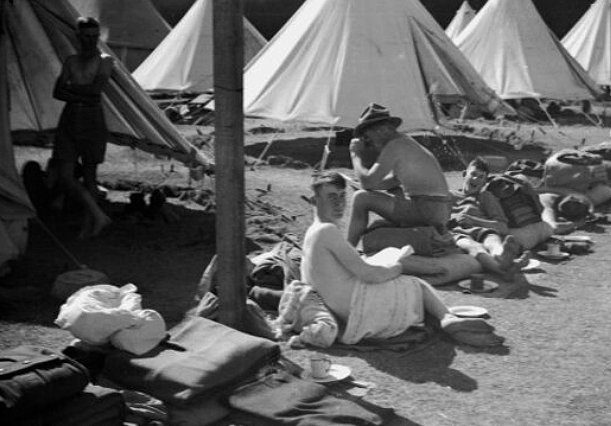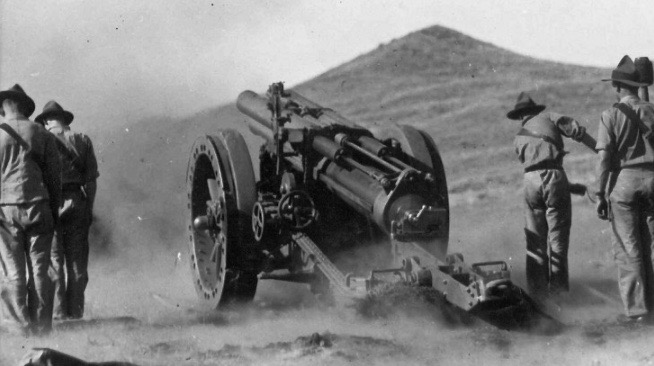20. Artillerymen
The Territorial artillery’s annual big
shoot
The
Army had indicated an interest in developing an artillery
training base at Waiouru since the mid 1920s. However it was
not until 1933 that formal approaches were made to landowners
for the use of their holdings. Instrumental in these
approaches was Major Park, an artillery officer based at
In the summer of 1936, Territorial artillery
held their first major camp at Waiouru. At this time the NZ
Army had about 10,000 artillerymen, 95% of them Territorials,
with twelve batteries of field guns, four batteries of 4.5in
howitzers, and batteries of coastal and light pack guns.

The field batteries that came to Waiouru were probably from
Auckland, Hamilton and Napier, and the howitzer battery from
Wellington. (There were other batteries in Nelson,
Christchurch and Invercargill)
There is no information on the number of artillerymen who
actually came to Waiouru, but there were enough to drink 400
litres of milk or more each day. Our local Hihitahi identity,
86-year-old Mrs Betty Mulvay (nee Grey) was a 14-year-old
farmer’s daughter living in the old Waiouru homestead at the
time.(Interview 2005)
"They
camped right round our house all summer. We were
milking 40 cows at the time, by hand, sending the
cream to Utiku, but during those summers all our milk
went to the soldiers.”

This presence became permanent in 1937 when
an artillery training camp was established at Waiouru, with
twenty buildings being put up to support the gunners, who
slept in shell-scrapes covered by white bell tents. 
Farmhand Cedric Arthur wrote in a letter to his fiancée:
(Arthur 1984)
"The military
camp is here again for its annual big shoot, so Waiouru
is exceedingly busy with huge lorries, tractors, guns
and horses, not to mention soldiers galore. They are
camped over at the old homestead and have a canteen and
every convenience for the tents, even to electric light,
while in the woolshed they have even rigged up a
"talkie" picture show!
Photos on the National Library’s website also show
artillerymen in a fenced paddock where the Irirangi
transmitters are now. They were armed with truck-tyred
18-pounder field guns and the 7-ton, solid tyred, 4.5 inch
60-pounder howitzers, which they defended with .303 rifles,
bren guns and Lewis guns.

Training
with defensive machine guns
The territorial artillerymen at Waiouru
were organised into “brigades,” each one with sixteen
18-pounders or twelve 60-pounders, as well as their
headquarters, observers, signallers, cooks, supply store, post
office, administration, mobile workshop, medical team, survey
troop etc.



Photos show that the December camps in the late 1930s were
held in warm sunny weather with almost a holiday atmosphere.
But this was not so for the December camp of 1940, as this
letter so vividly reveals when a live shoot was held,
apparently up the Burridge Estate road.

“The troops have been out all night with about 40
guns. The weather has been foul for days and the clay
roads have become quagmires.
When we set out for the shoot it began to rain again,
and this turned to hail followed by sleet. Then it
began to snow, and these conditions kept up all day.”

4.5
inch 60-pounder howitzers at Carbuncle in Dec 1937
“We got a ride up to the shoot on one of the big trucks,
up a valley that opens out from the back of the camp. We
crossed a narrow bridge covered in mud and then followed a
sort of trail of slush about 2 foot deep up to the gun
positions. The truck began to climb the hillocks and we
had to haul on the drag ropes to get her up. In addition
to nine passengers, we had a heavy load and towed a gun.”

“The going got really tough, with the hill sheer above us,
and drops of 30 feet or more below us. In the end we had
to unhook the gun and leave it on the hillside. It had
started to snow again, and we walked the rest of the way
up the valley to watch the shoot. The snow cleared up and
we watched the flashes of the guns flickering up and down
the valley.”

18-pounder
field guns
“It’s a wonder half the
guns and trucks were not smashed up that day. We were
back down in the valley when the first heavy truck came
over the ridge with a gun and ammunition trailer behind.
She got down about four yards when the back wheels
locked and she started to skid. The back slewed around
until the truck was sliding down on top of us sideways
with its gun following at right angles. Then she started
to tip, and everyone ran for their lives.”
“There were trucks bogged everywhere. We had to leave
nine guns out in the mud all night, but we hauled them
all out this morning.”
Bibliography
- Arthur,
P.M., 1984, Waiouru, Land of the Tussock, 1935–40.
-
Croom, F.G., 1941, The History of the Waiouru Military
Camp.
Next
21.
300 Tons of Nails
|











